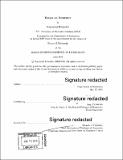| dc.contributor.advisor | Amy Finkelstein. | en_US |
| dc.contributor.author | Kluender, Raymond (Raymond Peter) | en_US |
| dc.contributor.other | Massachusetts Institute of Technology. Department of Economics. | en_US |
| dc.date.accessioned | 2018-09-17T15:55:09Z | |
| dc.date.available | 2018-09-17T15:55:09Z | |
| dc.date.copyright | 2018 | en_US |
| dc.date.issued | 2018 | en_US |
| dc.identifier.uri | http://hdl.handle.net/1721.1/118046 | |
| dc.description | Thesis: Ph. D., Massachusetts Institute of Technology, Department of Economics, 2018. | en_US |
| dc.description | Cataloged from PDF version of thesis. | en_US |
| dc.description | Includes bibliographical references. | en_US |
| dc.description.abstract | This thesis consists of three chapters on the economics of health insurance. In the first chapter, Carlos Dobkin, Amy Finkelstein, and Matthew Notowidigdo and I use an event study approach to examine the economic consequences of hospital admissions in two datasets: survey data from the Health and Retirement Study, and hospitalization data linked to credit reports. For non-elderly adults with health insurance, hospital admissions increase out-of-pocket medical spending, unpaid medical bills, and bankruptcy, and reduce earnings, income, access to credit, and consumer borrowing. The earnings decline is substantial compared to the out-of-pocket spending increase, and is minimally insured prior to age-eligibility for Social Security Retirement Income. Relative to the insured non-elderly, the uninsured non-elderly experience much larger increases in unpaid medical bills and bankruptcy rates following a hospital admission. Hospital admissions trigger fewer than 5 percent of all bankruptcies in our sample. In the second chapter, Evan Mast and I investigate an information friction in Medicare Advantage-beneficiaries pay two premiums, and one is much more salient. We find a larger demand elasticity for the salient versus non-salient premium. A model of insurer plan design produces simulated premiums matching the observed distribution using these "behavioral" elasticities, but not when assuming equal elasticities across the two premiums. Removing the friction increases enrollment in low-premium plans, increasing consumer surplus $5/year with supply fixed and $73/year when including a supply response. In the final chapter, I use difference-in-differences and triple-difference methods to understand the effects of the Affordable Care Act Medicaid expansion on a number of labor supply indicators and find no significant evidence of a labor supply response. | en_US |
| dc.description.statementofresponsibility | by Raymond Kluender. | en_US |
| dc.format.extent | 215 pages | en_US |
| dc.language.iso | eng | en_US |
| dc.publisher | Massachusetts Institute of Technology | en_US |
| dc.rights | MIT theses are protected by copyright. They may be viewed, downloaded, or printed from this source but further reproduction or distribution in any format is prohibited without written permission. | en_US |
| dc.rights.uri | http://dspace.mit.edu/handle/1721.1/7582 | en_US |
| dc.subject | Economics. | en_US |
| dc.title | Essays on insurance | en_US |
| dc.type | Thesis | en_US |
| dc.description.degree | Ph. D. | en_US |
| dc.contributor.department | Massachusetts Institute of Technology. Department of Economics | |
| dc.identifier.oclc | 1051459349 | en_US |
